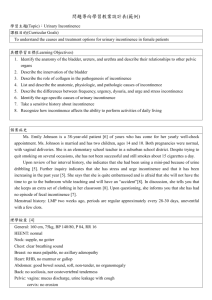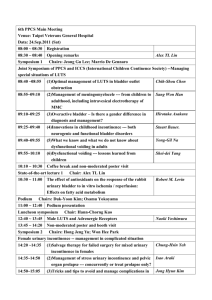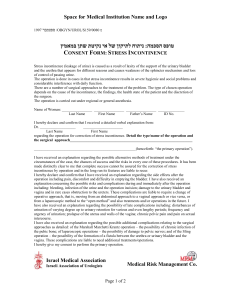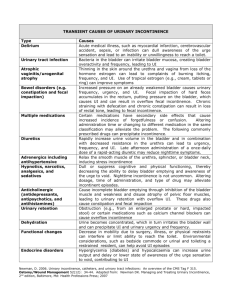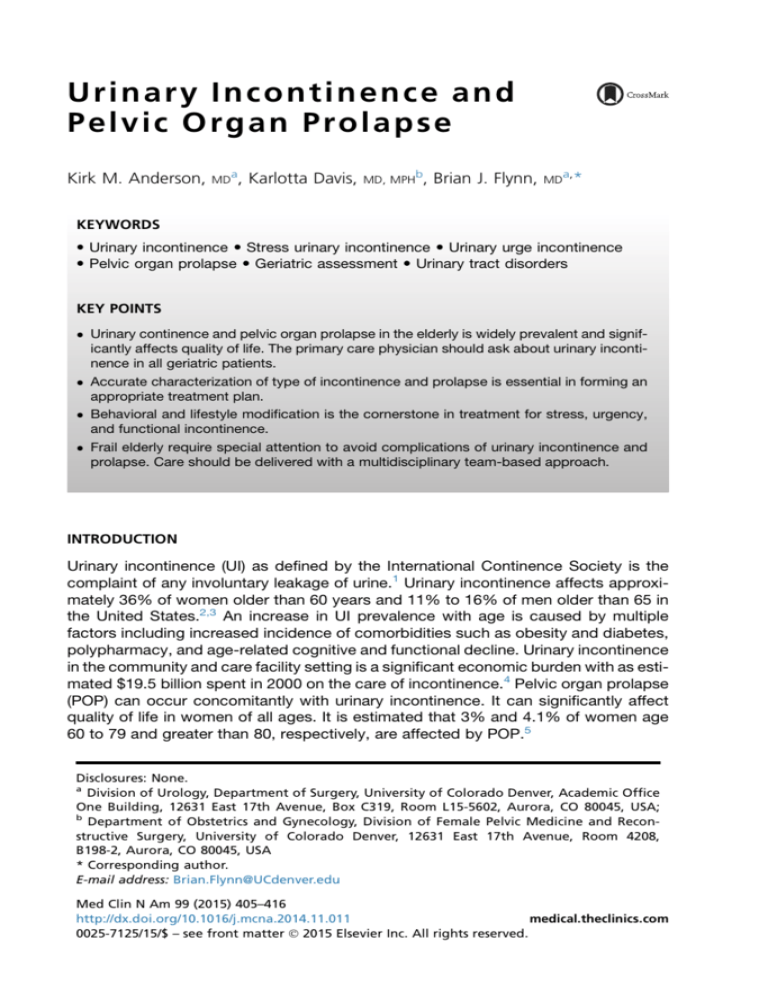
Urinary Incontinence and
P e l v i c O r g a n P ro l a p s e
Kirk M. Anderson,
MD
a
, Karlotta Davis,
MD, MPH
b
, Brian J. Flynn,
MD
a,
*
KEYWORDS
Urinary incontinence Stress urinary incontinence Urinary urge incontinence
Pelvic organ prolapse Geriatric assessment Urinary tract disorders
KEY POINTS
Urinary continence and pelvic organ prolapse in the elderly is widely prevalent and significantly affects quality of life. The primary care physician should ask about urinary incontinence in all geriatric patients.
Accurate characterization of type of incontinence and prolapse is essential in forming an
appropriate treatment plan.
Behavioral and lifestyle modification is the cornerstone in treatment for stress, urgency,
and functional incontinence.
Frail elderly require special attention to avoid complications of urinary incontinence and
prolapse. Care should be delivered with a multidisciplinary team-based approach.
INTRODUCTION
Urinary incontinence (UI) as defined by the International Continence Society is the
complaint of any involuntary leakage of urine.1 Urinary incontinence affects approximately 36% of women older than 60 years and 11% to 16% of men older than 65 in
the United States.2,3 An increase in UI prevalence with age is caused by multiple
factors including increased incidence of comorbidities such as obesity and diabetes,
polypharmacy, and age-related cognitive and functional decline. Urinary incontinence
in the community and care facility setting is a significant economic burden with as estimated $19.5 billion spent in 2000 on the care of incontinence.4 Pelvic organ prolapse
(POP) can occur concomitantly with urinary incontinence. It can significantly affect
quality of life in women of all ages. It is estimated that 3% and 4.1% of women age
60 to 79 and greater than 80, respectively, are affected by POP.5
Disclosures: None.
a
Division of Urology, Department of Surgery, University of Colorado Denver, Academic Office
One Building, 12631 East 17th Avenue, Box C319, Room L15-5602, Aurora, CO 80045, USA;
b
Department of Obstetrics and Gynecology, Division of Female Pelvic Medicine and Reconstructive Surgery, University of Colorado Denver, 12631 East 17th Avenue, Room 4208,
B198-2, Aurora, CO 80045, USA
* Corresponding author.
E-mail address: Brian.Flynn@UCdenver.edu
Med Clin N Am 99 (2015) 405–416
http://dx.doi.org/10.1016/j.mcna.2014.11.011
medical.theclinics.com
0025-7125/15/$ – see front matter Ó 2015 Elsevier Inc. All rights reserved.
406
Anderson et al
Lower urinary tract function is dependent on 2 basic processes: the ability to fill or
store urine and the ability to empty urine. In the absence of filling-phase dysfunction,
the bladder is able to accommodate an increasing volume of urine at low pressures.
This must occur in the absence of involuntary bladder contraction with adequate
bladder outlet resistance to avoid unwanted leakage of urine. Normal emptying
requires a coordinated contraction of detrusor muscle with a simultaneous decrease
in outlet resistance provided by the voluntary and involuntary sphincter mechanisms.
Lower urinary tract dysfunction can be broadly categorized as failure to fill or store or
empty owing to failure of the bladder, bladder outlet, or a combination (Fig. 1). Urinary
incontinence can result from a failure of either of these mechanisms or a combination.
Urinary incontinence is categorized as outlined in Table 1.
This article reviews the diagnosis and medical management of urinary incontinence
and prolapse in the outpatient primary care setting. Conditions that should prompt
referral to a surgical specialist are also briefly discussed.
INITIAL EVALUATION OF URINARY INCONTINENCE AND PELVIC ORGAN PROLAPSE
The initial evaluation in primary care should include a careful history, physical examination, and urinalysis. A thorough history can aid in distinguishing between the
different types of incontinence, although this can be difficult in elderly patients with
cognitive decline. Correctly identifying the type of urinary dysfunction is important
when considering management options, although many patients will have a combination of symptoms (Table 2). Additionally, it is important to determine if the UI is acute
or an established condition. Acute incontinence is typically a result of an acute change
that, once corrected, may resolve the incontinence. Consideration should be given to
various conditions that cause incontinence that may prompt referral to a surgical
specialist after the initial visit (Table 3). Microscopic (3 red blood cells per
high-power field on microscopy) or gross hematuria, rectal or prostatic mass, palpable
bladder, and failure of initial therapies should also prompt referral to a specialist
(Fig. 2).
Similar to UI, POP should be initially evaluated with a careful history and physical
examination. A thorough history can aid in distinguishing between the different types
of prolapse. The most common prolapse complaint is the awareness of a vaginal
Storage
Dysfunction
Combination
Fig. 1. Categorization of lower urinary tract dysfunction.
Emptying
Dysfunction
Urinary Incontinence and Pelvic Organ Prolapse
Table 1
Types of urinary incontinence
Stress incontinence
The complaint of involuntary leakage on effort or exertion or on
sneezing or coughing
Urge incontinence
The complaint of involuntary leakage accompanied by or
immediately preceded by urgency
Mixed incontinence
Combination of stress and urge incontinence
Overflow incontinence
Involuntary leakage of urine from a bladder at or near volume
capacity in the absence of detrusor contraction
Functional incontinence
Leakage of urine in the presence of physical or cognitive deficits and
in the absence of urinary system pathologic abnormality
bulge, fullness, or pressure. These indicators are owing to prolapse of the bladder
(cystocele), rectum (rectocele), or uterus (uterine prolapse). Patients with a cystocele
will frequently complain of difficulty emptying the bladder, urinary urgency, incomplete
emptying, and, rarely, urinary retention. Patients with a rectocele will complain of
difficulty with fecal evacuation and the need to splint to have a bowel movement.
Constipation may cause or be the result of a rectocele. Correctly identifying the
type of prolapse is important when considering management options. Failure of initial
therapies should also prompt referral to a specialist.
The evaluation in a specialist’s office will include components of the initial evaluation
and use of validated questionnaires, pad test to determine degree of incontinence,
bladder log (voiding diary), and assessment of postvoid residual. Cystoscopy and urodynamic testing may be indicated in more complex cases to characterize the type of
incontinence and direct overall treatment goals of both the patient and caregiver if
applicable.
CLASSIFICATION AND TREATMENT OF URINARY INCONTINENCE
Urinary incontinence is typically classified as stress, urge, overflow, or functional
incontinence. As previously stated, successful treatment is dependent on correctly
identifying the type of incontinence. Regardless of the type of incontinence, most
patients will initially use diapers or urinary pads. Although effective at allowing patients
to maintain dryness, pad usage is costly and can affect quality of life because of the
need for frequent changes and odor. For the frail elderly with limited mobility, infrequent pad or diaper changes can lead to skin breakdown and complex wounds. Caregivers should be educated on the importance of frequent diaper/pad changes to limit
the risk of skin complications.
Table 2
Common symptoms of lower urinary tract dysfunction
Storage Dysfunction
Emptying Dysfunction
Urinary frequency
Hesitancy
Urinary urgency
Straining
Nocturia
Urinary retention
UUI
Urinary frequency
SUI
407
408
Anderson et al
Table 3
Differential diagnosis to consider referral to specialist
Local Pathology
Female Factors
Bladder calculi
Vaginal atrophy
Bladder tumor
Vesicovaginal fistula
Metabolic Factors
Male Factors
Diabetes
Benign prostatic hypertrophy
Polydipsia
Prostate cancer
ACUTE INCONTINENCE
Acute onset of incontinence is typically caused by conditions separate from pathologic or anatomic changes in the genitourinary system. The most common causes
can be remembered with the pneumonic “DIAPERS” (Box 1). Once the underlying
cause of delirium is treated, UI typically resolves. Infection is a cause of acute incontinence and can be diagnosed based on symptoms, urinalysis, and urine culture.
Prescribing antibiotics in the setting of asymptomatic bacteruria should be avoided,
as this can result in adverse effects of antimicrobial medications and increase the
probability of developing drug-resistant microbial isolates in the future.6 The optimal
duration of antibiotics for an uncomplicated urinary tract infection is unknown. A
Fig. 2. Urinary incontinence management algorithm. BPH, benign prostatic hypertrophy.
Urinary Incontinence and Pelvic Organ Prolapse
Box 1
Causes of acute urinary incontinence
Delirium
Infection
Alcohol
Pharmaceuticals
Excess urine production
Reduced mobility
Stool impaction
Cochrane review found no difference in clinical failure rates when comparing a 3- to 6day course of antibiotics with a 7- to 14-day course in older women with uncomplicated urinary tract infection. Thus, a shorter course in such patients is recommended
to limit adverse effects of a prolonged course of antimicrobials.7
Alcohol and pharmaceuticals can also contribute to urinary incontinence by various
mechanisms of action (Table 4). Excess urine production can also precipitate UI.
Increasing volume of urine can be a result of increased urine production caused by
diuretic medications, excessive fluid consumption, and glucosuria. Additionally, conditions such as congenital heart failure, peripheral venous insufficiency, and hypoalbuminia/malnourishment can cause fluid retention that can result in excess urine
production. These conditions often occur in combination, and medical optimization
of each can reduce high volumes of urine production that may be precipitating UI.
Restricted mobility will be discussed further in the section covering functional incontinence. Finally, constipation is a risk factor for both transient and chronic urinary
incontinence.8 It is present in approximately one-third of people 60 years and older.9
In a cohort of women age 65 to 89 years with lower urinary tract symptoms and constipation, treatment of constipation resulted in decreased rates of urinary frequency
and urgency and reduced postvoid residual urine volume.10
STRESS URINARY INCONTINENCE
Stress urinary incontinence (SUI) is the involuntary leakage of urine during activities
that increase intra-abdominal pressure such as straining, lifting, or coughing. Stress
incontinence is uncommon in men with the exception of men who have had surgical
therapy of the prostate for benign or malignant disease. In women, stress incontinence
occurs primarily because of urethral hypermobility and intrinsic sphincter deficiency.
Table 4
Medications and mechanisms of action affecting continence
Mechanism of Action
Class of Medication
Increased urine production
Diuretics, thiazolidinediones, calcium channel
blockers, some anticonvulsants (latter 3
medications for fluid retention)
Sedation/immobility
Sedative hypnotics, antipsychotics, some
antidepressants, opiates
Increased bladder outlet resistance and/or
inhibited bladder contractility
a-adrenergic agonists, anticholinergics,
opioids, muscle relaxants
409
410
Anderson et al
Treatment of Stress Urinary Incontinence
Self-care, also known as lifestyle modification, should be the cornerstone of nonoperative management of UI. For example weight loss, smoking cessation, and avoidance
of triggers are simple nonoperative measures that can be effective in the motivated
patient. Obesity increases the risk of developing stress incontinence.11 In a randomized controlled trial of women with a mean body mass index of 36 and urinary incontinence, a 6-month diet and exercise program resulting in weight loss significantly
decreased the frequency of self-reported UI episodes.12
If self-care is ineffective, pelvic floor muscle training (PFMT), commonly referred to as
Kegel exercises, has been shown to improve the volume of leakage and number of
incontinent episodes in older men and women.13,14 Although the exact mechanism
by which improving strength of pelvic floor musculature improves continence is not
clear, there is sufficient evidence that PMFT is an important component of nonoperative
management of SUI. The optimal regimen of PFMT has not been determined; however,
the slight variation in techniques is less important in improving results than maintaining a
regular schedule of pelvic floor exercise. A suggested exercise regimen is shown in
Box 2. As with many lifestyle modifications programs, ensuring continued adherence
to the PMFT program is challenging. In a review of women 15 years after the end of a
formal PMFT program, only 28% maintained exercise at least on a weekly basis.15
The clinician should encourage the patient to incorporate PMFT into a daily routine
and ask at scheduled visits about adherence to their exercise program.
Another form of nonsurgical treatment of SUI in women is the vaginal pessary.
Although primarily used for pelvic organ prolapse, pessaries are found to improve
stress incontinence in women.16 Appropriate device and size selection is important
to optimize outcome. Care should be taken in the elderly population, as adequate
dexterity and cognitive function are essential to care for the device to avoid devastating complications from the neglected pessary.
In patients do not respond to nonsurgical therapy or those who are not motivated
to adhere to PMFT, there are several surgical options. Surgical therapy in women
typically includes bulking agents, colposuspension, and slings. In women fit for
surgery who are older than 70, slings are found to significantly improve continence
and patient-reported quality of life.17,18 Surgical therapy in men for SUI also includes
bulking agents and slings and artificial urinary sphincter placement for more severe
cases.
Box 2
Suggested pelvic floor muscle training and bladder training techniques
Pelvic floor muscle training
Contraction of pelvic floor muscle group for 2–10 seconds (maximum duration possible, with
progressive goal of 10–15 second contraction)
Sets of 10 pelvic floor muscle contractions
Repeat 3 times/d
Bladder training
Scheduled voiding with increasing intervals between voids to goal
Fixed interval voiding (in setting of pure stress incontinence to reduce bladder volume)
Urge inhibition techniques (meditation, distraction techniques, prompted pelvic floor
contraction)
Urinary Incontinence and Pelvic Organ Prolapse
URGENCY INCONTINENCE
Urinary urgency is the sudden compelling desire to void that is difficult to defer. When
this symptom coexists with incontinence, it is referred to as urge urinary incontinence
(UUI). Differences between SUI and UUI are outlined in Table 5. Overactive bladder is
the symptom complex of urinary urgency with frequency or nocturia with or without
incontinence. Normal bladder filling and storage is a result of complex interaction
between the cellular components of the bladder and the central and peripheral
nervous system that innervate and control voiding. Disruption of these components
can affect normal filling and result in unwanted bladder contraction and resultant UI.
Management options of UUI consists of behavioral and lifestyle modification, pharmacologic treatment, and surgery.
Treatment of Urgency Incontinence
Behavioral and lifestyle modification is the cornerstone in the initial management of
UUI (Fig. 3). The relationship between diet and urinary incontinence is not well established. Limiting alcohol intake and reducing caffeine intake to less than 200 mg/d (<2
cups of regular coffee) is suggested to reduce symptoms of urgency, although the
effects on incontinence are unknown.19 Pelvic floor muscle training may reduce
episodes of urgency incontinence; however, the benefits are less clear when
compared with improving SUI. Bladder training (see Box 2) should also be a component of lifestyle modification, although there are limited data showing significant
improvement.20 Bladder training and pelvic floor muscle training should be done in
combination when possible to reduce episodes of UUI.21
Pharmacologic management of UUI consists primarily of anticholinergic medications that block the effects of acetylcholine on the muscarinic receptors in the bladder.
Several antimuscarinic medications are available (Table 6) and data are insufficient to
suggest greater clinical efficacy for any one anticholinergic. These agents are generally
well tolerated but can cause significant dry mouth and constipation and are contraindicated in patients with closed-angle glaucoma. There have been reports of impaired
cognition with anticholinergic medications; however, this is uncommon. Immediaterelease oral oxybutynin in doses greater than 10 mg/d has been associated with
significant cognitive decline; however, in doses less than 10 mg/d the cognitive
side-effect profile is similar to that of other antimuscarinics. Anticholinergics should
be used with caution in patients with Alzheimer’s disease or in those taking an acetylcholinesterase inhibitors because of risk of acute worsening of dementia and delusions.22 Additionally, caution should be exercised in elderly patients with elevated
postvoid residual (PVR) urine volume. There is no well-established PVR above which
initiating an anticholinergic medication is absolutely contraindicated, although caution
Table 5
Differences between stress and urgency incontinence
Symptoms
Urgency Incontinence
Stress Incontinence
Urgency
Yes
No
Frequency
Yes
No
Leakage with activity
No
Yes
Amount leaked with incontinence episode
Large
Small/moderate
Ability to reach toilet in time with urge to void
No
Yes
Waking to void at night
Usually
Seldom
411
412
Anderson et al
Education
Pelvic Floor
Exercises
Timed
Voiding
Behavioral
Modification
Dietary and
Fluid
Changes
Reinforcement
Fig. 3. Behavioral and lifestyle modification principles.
should be exercised when PVR is greater than 150 mL. After initiating treatment with an
antimuscarinic in patients with an elevated PVR, it should be periodically monitored to
ensure adequate bladder emptying.
Mirabegron was recently introduced as an alternative to anticholinergics. It is a b-3
adrenergic receptor agonist and avoids the classic anticholinergic side effects such as
dry mouth, dry eyes, and constipation. The b-3 adrenergic receptor in the bladder wall
is normally stimulated by norepinephrine in the sympathetic pathway promoting
bladder relaxation during filling. This is a new class of medication that is promising
in the treatment of urinary urgency and UUI. It is found to be effective and well tolerated in patients older than 65 years with 1 year of follow-up.23
In patients with UUI refractory to lifestyle modification and pharmacologic therapy,
referral to a specialist is recommended. Surgical options for UUI include intravesical
injection of botulinium A toxin, percutaneous tibial nerve stimulation, and sacral nerve
stimulation and, in the most severe cases, bladder augmentation and urinary
diversion.
Table 6
Medications for treatment of urinary urgency and urgency incontinence
Common Dosing
Anticholinergic Medications
Oxybutynin (immediate release, extended release oral,
patch, gel)
2.5–5 mg PO BID-TID
5–15 mg PO qd
1 patch (3.9 mg/d) q 3 d
10% gel topically once daily
Tolterodine (immediate release, extended release)
1–2 mg PO BID
2–4 mg PO qd
Darifenacin
7.5 mg-15 mg PO qd
Solifenacin
5–10 mg PO qd
Trospium (immediate release, extended release)
20 mg PO BID
60 mg PO qd
Fesoterodine
4–8 mg PO qd
b-3 adrenergic agonist
Mirabegron
25–50 mg PO qd
Urinary Incontinence and Pelvic Organ Prolapse
OVERFLOW INCONTINENCE
Overflow incontinence is a result of failure to empty the bladder from bladder outlet
obstruction or inadequate bladder contractility. In men, the most common etiology
is bladder outlet obstruction from prostatic enlargement. In women, the most common
etiology is an acontractile bladder.
Treatment of Overflow Incontinence
In the acute setting, this should be managed with placement of a urethral catheter as
urine retention can cause acute kidney injury. Clean intermittent catheterization (CIC)
is preferred over continuous catheterization to lower the risk of urinary tract infection.24 However, in many elderly patients with retention, CIC is not practical because
of impairments in cognitive and physical skills. In this setting, an indwelling urethral or
suprapubic catheter may be more appropriate. In men and women with overflow
incontinence, referral to a specialist is recommended.
FUNCTIONAL INCONTINENCE
Functional incontinence is the term to describe UI in the presence of physical or cognitive deficits and in the absence of urinary system pathologic abnormality. It is
commonly diagnosed in the frail elderly. However, functional impairment should be
considered a risk factor for other types of incontinence, as most elderly patients
with a diagnosis of functional incontinence also have underlying stress, urge, or mixed
incontinence.25 Identifying functional barriers to normal voiding is an important part of
minimizing UI. In the acute setting, such as after hip fracture, barriers to toilet use
should be minimized. Use of bedside commode, condom catheters in men, and timing
of fluid intake to coincide with availability of caregivers may improve the immobile
patient’s ability to remain dry. Additionally, having caregivers available for toilet assistance can prevent episodes of incontinence.26
INCONTINENCE IN THE FRAIL ELDERLY
Incontinence in elderly persons who require assistance for activities of daily living can
adversely affect the patient’s overall health and quality of life and that of the caregiver.
An estimated 65% of nursing home residents have UI, and it is a leading cause for
placement into a long-term care facility.27 The International Consultation on Incontinence has issued guidelines for management of the frail elderly. Recommended lifestyle and behavioral modifications in this population are presented in Table 7. An
important component is caregiver investment into the goals of improving continence.28
The United States Center for Medicare and Medicaid services has issued guidelines on
Table 7
Behavioral and lifestyle modifications in the frail elderly
Prompted voiding
Prompting toilet use with contingent approval/praise
Goal of increasing patient requested/self-initiated toilet use
Habit retraining
Use of bladder diary and identification of timing of voiding with goal
of preempting incontinent episodes with planned toilet use
Timed voiding
Fixed interval toilet use in patients in absence of reinforcement or
patient education
Combined toileting
Physical exercise and pelvic floor training incorporating toilet
and exercise therapy
mobility techniques
413
414
Anderson et al
Table 8
Stages of pelvic organ prolapse
Stage 1
The most distal prolapse is more than 1 cm above the level of the hymen
Stage 2
The most distal prolapse is between 1 cm above and 1 cm below the hymen
Stage 3
The most distal prolapse is more than 1 cm below the hymen but no further than
2 cm less than TVL
Stage 4
Represents complete vault eversion; the most distal prolapse protrudes to at least
TVL 2 cm
Abbreviation: TVL, total vaginal length.
urinary incontinence in the surveyor community; however, it has been questioned
whether these guidelines have improved the quality of UI care in nursing home
residents.29,30
CLASSIFICATION AND TREATMENT OF PELVIC ORGAN PROLAPSE
Pelvic organ prolapse is typically classified by prolapsing organ and stage (1–4)
(Table 8).31 Stages 3 and 4 prolapse usually cause symptoms, such as incomplete
bladder empting, severe enough to warrant intervention. Regardless of the type of
POP, most women will be candidates for nonoperative management. Lifestyle modifications to avoid triggers that increase intra-abdominal pressure, such as constipation, obesity, chronic cough, and lifting, should be eliminated. Similar to treatment
for UI, PFMT is also effective in strengthening the pelvic floor and improving POP.32
A pessary is a silicone device that is inserted into the vagina to provide support and
improve symptoms of vaginal pressure and improve bladder emptying. Pessaries
come in various shapes and sizes and need to be fitted properly to fit the patient’s
anatomy (Fig. 4). Proper fitting, education, and careful follow-up by a pelvic floor
specialist are paramount in optimizing outcomes and avoiding a forgotten foreign
body.
Fig. 4. Commonly used pessaries: Support (A), space filling (B), incontinence support (C).
Urinary Incontinence and Pelvic Organ Prolapse
SUMMARY
Urinary incontinence and pelvic organ prolapse are widely prevalent problems in the
elderly population in both community and care facility settings. The primary care
physician should be proactive in identifying UI and POP and engaging the patient
and caregivers in a multimodal approach to management. Ancillary health care staff
also serves as an important adjunct in sustaining improvements obtained through lifestyle and behavioral modifications. Referral to surgical specialists in the appropriate
setting is an important component of the multidisciplinary approach that is necessary
in achieving patient and caregiver goals.
REFERENCES
1. Abrams P, Cardozo L, Fall M, et al. The standardisation of terminology of lower
urinary tract function: report from the standardisation sub-committee of the international continence society. Neurourol Urodyn 2002;21(2):167–78.
2. Dooley Y, Kenton K, Cao G, et al. Urinary incontinence prevalence: results from
the National Health and Nutrition Examination Survey. J Urol 2008;179(2):656–61.
3. Markland AD, Goode PS, Redden DT, et al. Prevalence of urinary incontinence in
men: results from the national health and nutrition examination survey. J Urol
2010;184(3):1022–7.
4. Hu TW, Wagner TH, Bentkover JD, et al. Costs of urinary incontinence and overactive bladder in the United States: a comparative study. Urology 2004;63(3):
461–5.
5. Nygaard I, Barber MD, Burgio KL, et al. Prevalence of symptomatic pelvic floor
disorders in US women. JAMA 2008;300(11):1311–6.
6. Abrutyn E, Mossey J, Berlin JA, et al. Does asymptomatic bacteriuria predict
mortality and does antimicrobial treatment reduce mortality in elderly ambulatory
women? Ann Intern Med 1994;120(10):827–33.
7. Lutters M, Vogt-Ferrier NB. Antibiotic duration for treating uncomplicated, symptomatic lower urinary tract infections in elderly women. Cochrane Database Syst
Rev 2008;(3):CD001535.
8. Carter D, Beer-Gabel M. Lower urinary tract symptoms in chronically constipated
women. Int Urogynecol J 2012;23(12):1785–9.
9. American Gastroenterological Association, Bharucha AE, Dorn SD, et al. American Gastroenterological Association medical position statement on constipation.
Gastroenterology 2013;144(1):211–7.
10. Charach G, Greenstein A, Rabinovich P, et al. Alleviating constipation in the
elderly improves lower urinary tract symptoms. Gerontology 2001;47(2):72–6.
11. Osborn DJ, Strain M, Gomelsky A, et al. Obesity and female stress urinary incontinence. Urology 2013;82(4):759–63.
12. Subak LL, Wing R, West DS, et al. Weight loss to treat urinary incontinence in
overweight and obese women. N Engl J Med 2009;360(5):481–90.
13. Sherburn M, Bird M, Carey M, et al. Incontinence improves in older women after
intensive pelvic floor muscle training: an assessor-blinded randomized controlled
trial. Neurourol Urodyn 2011;30(3):317–24.
14. Pereira VS, Escobar AC, Driusso P. Effects of physical therapy in older women
with urinary incontinence: a systematic review. Rev Bras Fisioter 2012;16(6):
463–8.
15. Bo K, Kvarstein B, Nygaard I. Lower urinary tract symptoms and pelvic floor muscle exercise adherence after 15 years. Obstet Gynecol 2005;105(5 Pt 1):
999–1005.
415
416
Anderson et al
16. Farrell SA, Singh B, Aldakhil L. Continence pessaries in the management of
urinary incontinence in women. J Obstet Gynaecol Can 2004;26(2):113–7.
17. Carr LK, Walsh PJ, Abraham VE, et al. Favorable outcome of pubovaginal slings
for geriatric women with stress incontinence. J Urol 1997;157(1):125–8.
18. Walsh K, Generao SE, White MJ, et al. The influence of age on quality of life
outcome in women following a tension-free vaginal tape procedure. J Urol
2004;171(3):1185–8.
19. Wyman JF, Burgio KL, Newman DK. Practical aspects of lifestyle modifications
and behavioural interventions in the treatment of overactive bladder and urgency
urinary incontinence. Int J Clin Pract 2009;63(8):1177–91.
20. Wallace SA, Roe B, Williams K, et al. Bladder training for urinary incontinence in
adults. Cochrane Database Syst Rev 2004;(1):CD001308.
21. Shamliyan TA, Kane RL, Wyman J, et al. Systematic review: randomized,
controlled trials of nonsurgical treatments for urinary incontinence in women.
Ann Intern Med 2008;148(6):459–73.
22. Pagoria D, O’Connor RC, Guralnick ML. Antimuscarinic drugs: review of the
cognitive impact when used to treat overactive bladder in elderly patients. Curr
Urol Rep 2011;12(5):351–7.
23. Wagg A, Cardozo L, Nitti VW, et al. The efficacy and tolerability of the
beta3-adrenoceptor agonist mirabegron for the treatment of symptoms of overactive bladder in older patients. Age Ageing 2014;43(5):666–75.
24. Hooton TM, Bradley SF, Cardenas DD, et al. Diagnosis, prevention, and treatment
of catheter-associated urinary tract infection in adults: 2009 International Clinical
Practice Guidelines from the Infectious Diseases Society of America. Clin Infect
Dis 2010;50(5):625–63.
25. Resnick NM, Yalla SV, Laurino E. The pathophysiology of urinary incontinence
among institutionalized elderly persons. N Engl J Med 1989;320(1):1–7.
26. Gibbs CF, Johnson TM 2nd, Ouslander JG. Office management of geriatric
urinary incontinence. Am J Med 2007;120(3):211–20.
27. Newman DK. Urinary incontinence, catheters, and urinary tract infections:
an overview of CMS tag F 315. Ostomy Wound Manage 2006;52(12):34–6, 38,
40–4.
28. Booth J, Kumlien S, Zang Y. Promoting urinary continence with older people: key
issues for nurses. Int J Older People Nurs 2009;4(1):63–9.
29. Surveyor Guidance for Incontinence and Catheters. State operations manual
(SOM). Baltimore (MD): Department of Health & Human Services, Centers for
Medicare & Medicaid Services. 2005.
30. DuBeau CE, Ouslander JG, Palmer MH. Knowledge and attitudes of nursing
home staff and surveyors about the revised federal guidance for incontinence
care. Gerontologist 2007;47(4):468–79.
31. Bump RC, Mattiasson A, Bo K, et al. The standardization of terminology of female
pelvic organ prolapse and pelvic floor dysfunction. Am J Obstet Gynecol 1996;
175(1):10–7.
32. Braekken IH, Majida M, Engh ME, et al. Can pelvic floor muscle training reverse
pelvic organ prolapse and reduce prolapse symptoms? An assessor-blinded,
randomized, controlled trial. Am J Obstet Gynecol 2010;203(2):170.e1–7.



